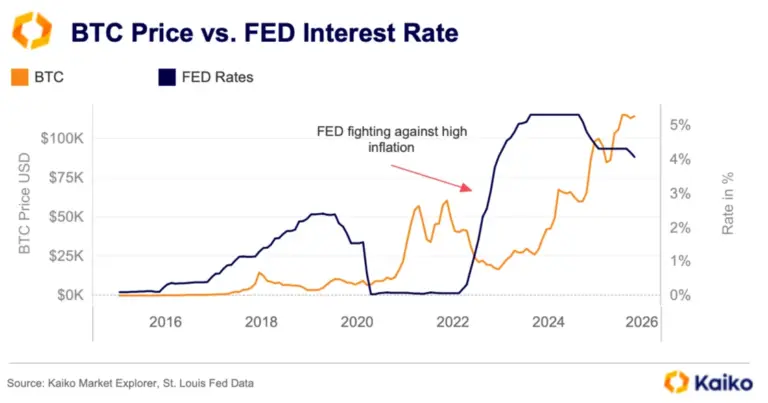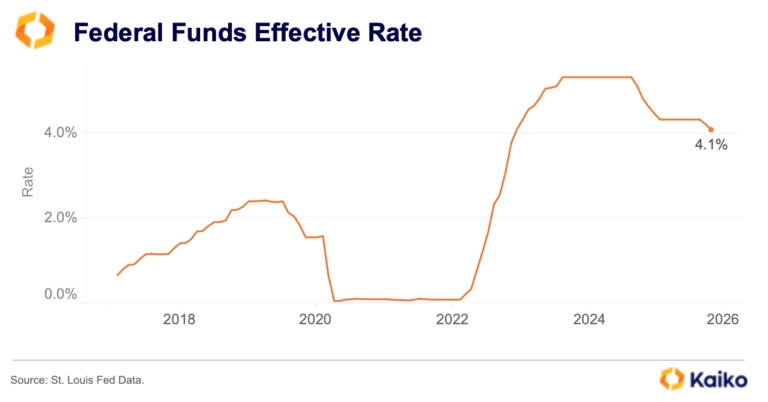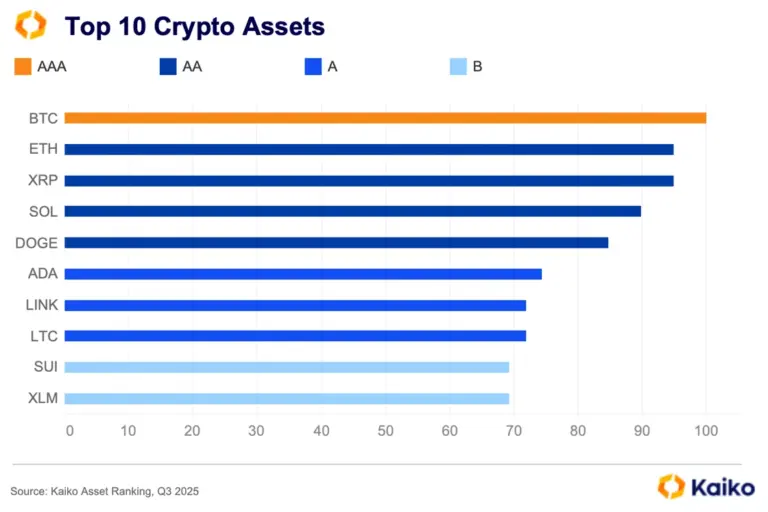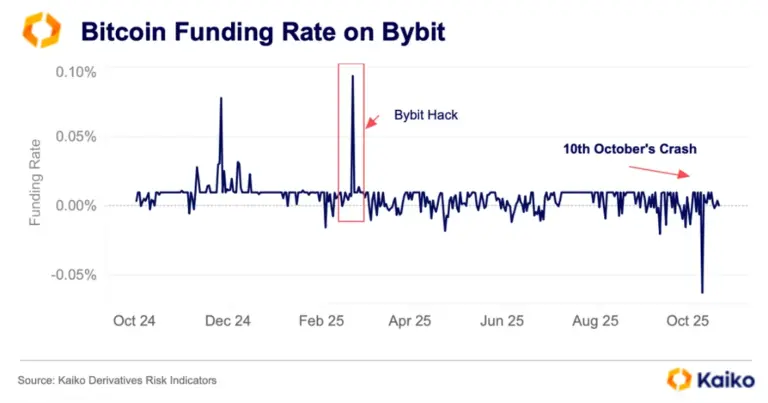Last week’s crash wasn’t just a market event — it was a live-fire test of the infrastructure underpinning crypto markets. In a period under 30 minutes, every asset whipsawed, long‑tail tokens sold off sharply, and oracle designs faltered. The lack of uniformity across markets determined who was liquidated, who accrued bad debt, and who ultimately paid the price.
Crypto’s Pricing Problem Laid Bare
There has been plenty of talk about last week’s crash, but too little focus on the infrastructure issues the sell‑off exposed. Token prices had already been declining on Friday afternoon, but shortly before 9 p.m. UTC, following President Trump’s tariff threats on social media, crypto prices fell off a cliff.
The rapid sell-off concluded 20 minutes later, around 9:20 p.m. UTC, wiping out order books and exposing a fundamental weakness in crypto’s infrastructure. For example, Kraken is one of the oldest and liquid exchanges in the industry. Yet, at several points on Friday, there was virtually no liquidity on either side of its order books (buy or sell), simply because market makers withdrew.

Why did this happen? Beyond the panic itself, a key factor was the significant price discrepancies between exchanges, even for major cryptocurrencies like BTC, which are usually more consistent from venue to venue. In short, at that moment, no one really knew the true value of any cryptocurrency, because prices varied so widely from one platform to another.
When we compare Kraken’s BTC-USD price at the time with our Reference Rates, we see that as Kraken’s order book was cleared around 9:27 p.m., its price fell to $100,000, Meanwhile, Kaiko’s BTC-USD rate (the orange line) never fell below $104,000..png?upscale=true&width=1120&upscale=true&name=Screenshot%202025-10-17%20at%2013.24.03%20(1).png)
The divergence from the Kaiko Indices BTC-USD Reference Rate — a rate designed to offer a truly reliable benchmark value for BTC — underscores the importance of robust pricing practices. During the crash, some venues traded at a premium while others traded at a discount. This occurred in spot markets and also transmitted to derivatives markets that reference spot markets for settlement. When spot pricing dislocates, market functioning deteriorates quickly.
The impact can be even more severe for less liquid assets, such as USDe, which exhibited larger cross‑venue basis and wider dislocations. USDe, bSOL, and wbETH were among those most affected: their prices dislocated on Binance’s spot market, leading to misvaluation of perp positions collateral on the exchange, and contributing to additional liquidations. The underlying issue comes from sourcing prices from a single venue because when a local malfunction occurs, it can trigger system-wide effects. Using a Reference Rate that bases its price on multiple venues would have avoided this risk. Robust prices need proper data infrastructure, which means pulling from multiple venues without missing a trade.
The underlying issue comes from sourcing prices from a single venue because when a local malfunction occurs, it can trigger system-wide effects. Using a Reference Rate that bases its price on multiple venues would have avoided this risk. Robust prices need proper data infrastructure, which means pulling from multiple venues without missing a trade.
Traditional financial markets mitigate this risk by using benchmark indices and multi-venue data aggregation to ensure that reference prices reflect broad market conditions rather than a single exchange’s order book. Crypto markets are now big enough to finally catch up.
Oracle’s and On-chain Blunders
The shortcomings were not limited to centralized venues, even though Binance and others drew most of the criticism. Aave, the largest lending and borrowing protocol by total value locked, also experienced minor issues with some of its oracles.
CRV and ENS prices diverged from the broader market because several blocks were delayed, with deviations of 30% to 40%. Despite the system’s overall resilience, this led to a limited accumulation of bad debt.

Overall, Aave managed the market shock well: roughly $500k in bad debt and about $180 million in liquidations were processed smoothly. Even so, the episode highlights how crucial it is to improve not only oracle reliability, but also the underlying market data those oracles ingest.
Crypto is highly volatile and prone to sharp swings, with external events often exerting outsized influence on prices. Last Friday’s flash crash will not be the last, and it’s a timely reminder for venues to invest in infrastructure that can cushion such shocks.
For example, Kaiko already publishes on-chain on Arbitrum, reference rates via a simple interface and a batched refresh transaction that updates all supported pairs at once. This can serve as the primary feed for selected assets, or as a fast fallback that activates when the main feed is stale or flagged. In events like last Friday’s, this design reduces stale-value risk.
For data providers, it’s about moving beyond monolithic approaches. Any data used to bring capital markets on-chain cannot rely on decentralized sources alone — they must encompass the complete market for an asset, with real-time accuracy.
Beyond Monolithic Infrastructure & Pricing Practices
This point becomes even clearer when looking at how different assets are priced in practice. Pricing BTC, DOGE, and the NASDAQ-100 is not the same. This is due to two main factors: their fundamentally different risk profiles and the way these assets trade. While equities benefit from regulated, centralized markets with deep liquidity and built-in safeguards, crypto assets trade across fragmented venues with uneven liquidity and execution quality.
As equity markets traded down into the close and after hours, minute-by-minute returns showed a clear divergence between the burgeoning asset class and the NASDAQ-100. During the October 10 crash, Bitcoin and Dogecoin experienced much sharper price swings than traditional equities. Even after adjusting for volatility, crypto returns displayed heavier tails, reflecting higher sensitivity to liquidity shocks and structural fragility. Reliable and harmonized pricing data remains essential to narrowing this gap between digital assets and traditional markets.
 Despite maturing over the past two years, crypto markets still lag traditional venues in risk management. If venues can’t independently establish standards around pricing, contracts, and collateral to protect users, regulators will need to enforce global standards to prevent repeats of events like last Friday.
Despite maturing over the past two years, crypto markets still lag traditional venues in risk management. If venues can’t independently establish standards around pricing, contracts, and collateral to protect users, regulators will need to enforce global standards to prevent repeats of events like last Friday.
Actionable next steps for exchanges and DeFi protocols include adopting fail-safe protections, whether for token minting or data sourcing. Just as multiple steps and verifications could have avoided PYUSD’s fat-finger error, venue dispersion and volatility flags in price data could have reduced the likelihood of cliff-edge liquidations.
Fat-finger Highlights Persistent Infra Risks
Another infrastructure failure was Wednesday’s fat‑finger issue with PYUSD which highlights weaknesses in crypto infrastructure once again. The stablecoin, which typically has a circulating supply of about $2.6bn, briefly appeared to spike to roughly 10× U.S. government debt when $300trn was issued in error.

The error was quickly reversed, but events like this, along with the on- and off-chain mispricing issues last week, emphasize the need for more rigorous infrastructure in crypto. If this sort of error occurred on a systemically important stablecoin, such as USDC or USDT, the impact on the market could have been catastrophic.
These issues are not isolated — Bitcoin had its own minting issue in August 2010, when a bug allowed 184bn BTC to be minted in block 74,638. The issue was patched within hours, and a soft fork ensured it could not happen again. This occurred before BTC was mainstream and highlights how far the asset has come. The rest of the market should follow.
The PYUSD example is just the latest infrastructure mishap in crypto and a stark reminder that we need to implement robust practices across every part of the market to fully integrate with the broader financial system. For stablecoin infrastructure, this means using rigorous best practices, such as three validation steps and a four-eyes approach.
For data providers, the goal is to move past one-size-fits-all architectures. Data for on-chain capital markets can’t depend solely on decentralized sources; it needs to reflect the full market for each asset, delivered with real-time precision.
This article is a special edition of Kaiko Research. Subscribe here to receive weekly research, powered by Kaiko data.


![]()
![]()
![]()
![]()



.png?upscale=true&width=1120&upscale=true&name=Screenshot%202025-10-17%20at%2013.24.03%20(1).png)
 The underlying issue comes from sourcing prices from a single venue because when a local malfunction occurs, it can trigger system-wide effects. Using a Reference Rate that bases its price on multiple venues would have avoided this risk. Robust prices need proper data infrastructure, which means pulling from multiple venues without missing a trade.
The underlying issue comes from sourcing prices from a single venue because when a local malfunction occurs, it can trigger system-wide effects. Using a Reference Rate that bases its price on multiple venues would have avoided this risk. Robust prices need proper data infrastructure, which means pulling from multiple venues without missing a trade.
 Despite maturing over the past two years, crypto markets still lag traditional venues in risk management. If venues can’t independently establish standards around pricing, contracts, and collateral to protect users, regulators will need to enforce global standards to prevent repeats of events like last Friday.
Despite maturing over the past two years, crypto markets still lag traditional venues in risk management. If venues can’t independently establish standards around pricing, contracts, and collateral to protect users, regulators will need to enforce global standards to prevent repeats of events like last Friday.



